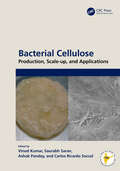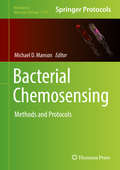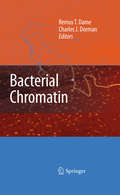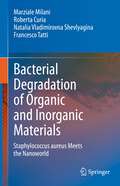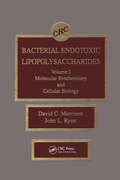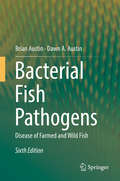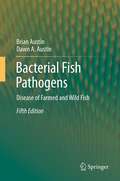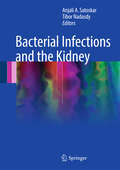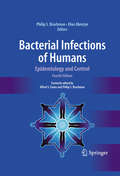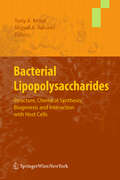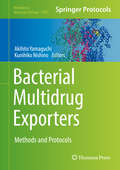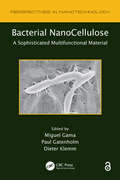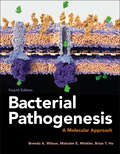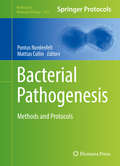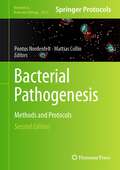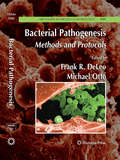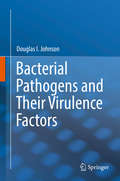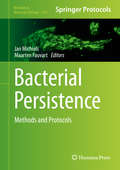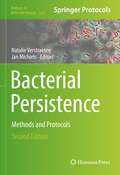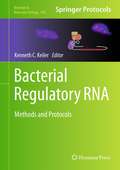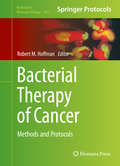- Table View
- List View
Bacterial Cellulose: Production, Scale-up, and Applications
by Vinod Kumar Carlos Ricardo Soccol Ashok Pandey Saurabh SaranThis reference book provides updated information on the production and industrial significance of bacterial cellulose. Bacterial cellulose is a natural fiber produced by certain microbes, mainly bacteria which belong to the Acetobacter genera. The book discusses its applications in different industrial sectors, such as food, pharmaceutical, energy, and wastewater treatment. It covers the production of cellulose from conventional and renewable feedstock and includes topics such as downstream processing, characterization, and chemical modification of bacterial cellulose. FEATURES Addresses the challenges of the production technologies of bacterial cellulose up to pilot scale Discusses cost-effective green processes using agri-processing residues and medium formulation Includes efficient preparation of nanocomposites using in vitro and in vivo methods Provides the latest applications of bacterial cellulose in the food and pharmaceuticals fields Reviews the production of bacterial cellulose from conventional feedstock such as sugars and starches This book is designed for industry experts and researchers of applied microbiology, bioprocesses, and industrial microbiology.
Bacterial Chemosensing: Methods And Protocols (Methods In Molecular Biology #1729)
by Michael D. MansonThis volume covers a wide range of up-to-date technologies that have been successfully applied to study the chemosensing behavior of the traditional model species, such as Escherichia coli and Salmonella typhimurium, while being also applicable to a wide spectrum of other species. Beginning with an introduction, the sections of the book explore methods for studying bacterial chemotaxis at the population and whole-cell levels, in vivo analysis of receptor function, cryo-EM methods for studying chemoreceptor structure, as well as intracellular movement of chemosensory proteins, high-throughput methods to screen for novel chemoeffectors, and chemical tools and computer simulations for analyzing chemotaxis. Written for the highly successful Methods in Molecular Biology series, chapters include brief introductions to their topics, lists of the necessary materials and reagents, step-by-step, readily reproducible laboratory protocols, and tips for troubleshooting and avoiding known pitfalls. Authoritative and cutting-edge, Bacterial Chemosensing: Methods and Protocols provides an extensive repertoire of approaches that can be extended to understanding chemotaxis, in particular, and chemosensing, in general, in the context of the enormously varied lifestyles adopted in the larger bacterial world.
Bacterial Chromatin
by Charles J. Dorman Remus T. DameThe relative simplicity of the bacterial cell, short generation times and well defined and inexpensive culturing conditions have significantly contributed to our understanding of many complex biological systems. Yet the workings of the bacterial genome, seemingly impossibly compressed within a tiny nucleoid, have remained elusive. How is it that bacteria are able to package their genetic information within the confined space of the nucleoid while at the same time making it accessible for gene expression and DNA replication? This book, featuring the latest research by leading experts, describes the advanced methods being applied to the problem and shows how their work is contributing to our growing understanding of the ways that bacterial DNA storage, replication, recombination and gene expression are managed and coordinated. With due consideration paid to archaea and eukaryotes, the authors show how evolution in bacteria has provided solutions to these problems that range from the very sophisticated to the surprisingly simple. This comprehensive overview of bacterial chromatin clearly defines the fundamental concepts and goes on to show how cells inherit both chromosomal and extra-chromosomal genetic information at cell division. Several chapters are devoted to the central role played by nucleoid-associated proteins, with specific material on imaging the nucleoids, the physics of their structure and segregation, and the transcriptional regulation conducted by nucleoid-associated proteins. No other book currently available provides such a complete picture of these essential cellular processes.
Bacterial Degradation of Organic and Inorganic Materials: Staphylococcus aureus Meets the Nanoworld
by Marziale Milani Roberta Curia Natalia Vladimirovna Shevlyagina Francesco TattiThis interdisciplinary work deals with the bacterial degradation of organic and inorganic materials such as prosthetic devices and the consequent production of non-engineered nanoparticles (NPs). Focus is put on the interaction of these, often toxic, NPs with the environment, the microorganisms and the host human body. Electron Microscopy is the method of choice to investigate bacterial colonization and degradation of plastic polymers. Hence one section of the book is fully dedicated to the most recent and interesting microscopy technologies in microbiology and soft matters. The final chapter of the book on the complex and multivariate relationships between a microscopist and electron microscopy images is dedicated to Lyubov Vasilievna Didenko (1958 – 2015), a passionate researcher who contributed substantially to the field of Electron Microscopy research and its applications in studying bacterial-polymer interactions. The book addresses researchers and advanced students working in general and clinical microbiology, nanobiology, materials sciences and image analysis fields.
Bacterial Endotoxic Lipopolysaccharides
by David C. Morrison John L. RyanBacterial Endotoxic Lipopolysaccharides provides an up-to-date, two-volume review of the latest information regarding bacterial lipopolysaccharide structure and activities. These volumes cover the biochemistry, pharmacology, and pathophysiologic properties of endotoxins. The volumes also thoroughly discuss the strengths and weaknesses of new therapies for septic shock that are based on an immunological attack on endotoxins and the cytokines induced by endotoxins. All scientists involved in endotoxin research, clinical infectious disease specialists, and medical students interested in the pathogenesis of septic shock will find Bacterial Endotoxic Lipopolysaccharides invaluable as a reference resource.
Bacterial Fish Pathogens: Disease of Farmed and Wild Fish (Springer Praxis Books / Aquaculture And Fisheries Ser.)
by Dawn A. Austin Brian AustinThis book puts emphasis on theisolation, taxonomy, diagnosis (phenotypic, serology and molecular biology),epizootiology, pathogenicity mechanisms, and methods of disease control (byvaccination, immunostimulation, probiotics, prebiotics, plant products, andantimicrobial compounds. Co-infections, which are attributed to more than onemicrobial species have been discussed. Shortcomings in knowledge have beenhighlighted. This sixth edition is the successor to the original version, first published in 1987, and which fillsthe need for an up-to-date comprehensive text on the biological aspects of thebacterial taxa which cause disease in finfish. Thebook is primarily targeted at researcher workers, including postgraduatestudents, and diagnosticians. It is anticipated that the readership willinclude veterinary microbiologists, public health scientists and microbialecologists.
Bacterial Fish Pathogens: Disease of Farmed and Wild Fish (Springer Praxis Books / Aquaculture And Fisheries Ser.)
by Dawn A. Austin Brian AustinThis completely updated fifth edition of Bacterial Fish Pathogens is a comprehensive discussion of the biological aspects of the bacteria which cause disease in farmed and wild fish. Since the 4th edition was published in 2007, there has been an upturn in the application of molecular approaches to taxonomy, diagnosis and vaccine development. New pathogens, e.g. Aeromonas schubertii, have been described. Also, there has been the emergence of diseases caused by bacteria which have not been cultured, and which have been equated with new taxa, i.e. 'Candidatus'. Consideration is given to all the bacterial fish pathogens, including primary pathogens and opportunists.
Bacterial Identification and Drug Susceptibility Patterns in Pregnant and Non Pregnant UTI Patients (SpringerBriefs in Applied Sciences and Technology)
by Syeda Sograh Fatima Eman Al MussaedThis book provides a review of essential research on urinary tract infections (UTIs), as well as a broader perspective on methodologies adopted for the isolation and identification of the bacteria from urine samples of pregnant and non-pregnant women on the basis of their cultural, morphological and biochemical characteristics. The identification is extended to the strain level by means of molecular identification involving BLAST as a bioinformatics tool. The book also addresses the roles of various other bioinformatics tools for tracing the phylogenetic tree and conservation studies among the bacteriocin of the identified bacteria. Lastly, it assesses the antibiotics resistance patterns of these isolates.
Bacterial Infections and the Kidney
by Anjali A. Satoskar Tibor NadasdyThis text is designed to present a comprehensive and state-of the-art but practical approach to the diagnosis and management of bacterial infection associated renal disease. The chapters address the different types of glomerular, tubulointerstitial and vascular diseases, associated with bacterial infections, describe diagnostic pitfalls, provide differential diagnosis and discuss treatment and management. Easy to follow diagnostic algorithms and tables are included for practical usefulness. The text provides a large number of color microphotographs, illustrations and each chapter refers to the most important up to date literature in the area. All chapters are written by experts in the field and will include the most up-to-date clinical information. A comprehensive but user friendly resource on renal complications of bacterial infection, such as this book, is overdue, particularly now in the era of staphylococcus epidemic and emerging new resistant bacterial strains. Bacterial Infections and the Kidney will be an important resource for pathologists, nephrologists, general internists, infectious disease specialists, and urologists. Transplant surgeons may find the chapter on transplant pyelonephritis very useful.
Bacterial Infections of Humans: Epidemiology and Control
by Elias Abrutyn Philip S. BrachmanThe new Fourth Edition of Bacterial Infections of Humans reflects a decade of important discoveries, technological progress, and valuable new therapies as well as emerging and reemerging infections, resistant strains of bacteria, and threats of bioterrorism. It offers accessible, up-to-date information across the range of disease entities. As in previous editions, introductory chapters review general concepts of infection and epidemiology, and the chapters devoted to specific infections follow a consistent and highly useful format: historical background, methodology (diagnosis and pathology), biology, descriptive epidemiology, mechanism and routes of transmission, pathogenesis, host responses, methods of prevention and control, and areas for future research. All material has been thoroughly updated, and two chapters on molecular epidemiology and health care-acquired bacterial infections, are entirely new. A sampling of the 40 diseases and clinical syndromes covered in the Fourth Edition: Anthrax Bacterial foodborne disease Chlamydia E. coli Legionellosis Meningitis Q fever Tuberculosis Bacterial Infections of Humans has been noted for ably complementing textbooks on the subject, and this most current edition remains a major reference for professionals in the field, including public health practitioners, microbiologists, immunologists, researchers studying pathogenic bacteria, clinicians working with infectious disease, and medical or nursing students.
Bacterial Lipopolysaccharides: Structure, Chemical Synthesis, Biogenesis and Interaction with Host Cells
by Miguel A. Valvano Yuriy A. KnirelThe bacterial lipopolysaccharide also known as endotoxin is exhaustively covered in the present work. Central emphasis is placed upon the fine chemical structure of the lipopolysaccharide and its significance for understanding their activity and function. In particular, the role it plays in the interaction of bacteria with other biological systems is examined. New aspects of their physicochemical biology are introduced and updates to the current knowledge concerning the lipopolysaccharide are provided. This important class of biomolecules has recently attracted the attention of many investigators, in particular for understanding its involvement in innate immunity, toll-like receptor recognition and intracellular signaling.
Bacterial Multidrug Exporters: Methods and Protocols (Methods in Molecular Biology #1700)
by Akihito Yamaguchi Kunihiko NishinoThis detailed volume utilizes our current understanding of the structural basis of multidrug recognition and multidrug efflux mechanisms to provide protocols involving these vital intrinsic membrane proteins widely distributed in bacteria. Beginning with protocols for the structural analysis of bacterial multidrug exporters, the book continues with sections on biochemical and bioengineering analysis, computational analysis, biomedical approaches, as well as advanced technologies expected to be applied to multidrug efflux transport studies. Written in the highly successful Methods in Molecular Biology series format, chapters include introductions to their respective chapters, lists of the necessary materials and reagents, step-by-step, readily reproducible laboratory protocols, and tips on troubleshooting and avoiding known pitfalls. Authoritative and practical, Bacterial Multidrug Exporters: Methods and Protocols serves as an ideal guide to this fast moving field of study.
Bacterial NanoCellulose: A Sophisticated Multifunctional Material (Perspectives In Nanotechnology Ser. #9)
by Miguel GamaThe first book dedicated to the potential applications and unique properties of bacterial cellulose (BC), this seminal work covers the basic science, technology, and economic impact of this bulk chemical as well as the companies and patents that are driving the field. It reviews the biosynthesis and properties of BC, including genetics and characterization; discusses the advancing technology as it relates to product development, bioreactors, and production; and analyzes the economic impact of BC on a diverse range of industry applications, including materials and biomaterials, biological and polymer sciences, and electromechanical engineering.
Bacterial Pathogenesis: A Molecular Approach (ASM Books)
by Brenda A. Wilson Malcolm Winkler Brian T. HoThis highly anticipated update of the acclaimed textbook draws on the latest research to give students the knowledge and tools to explore the mechanisms by which bacterial pathogens cause infections in humans and animals. Written in an approachable and engaging style, the book uses illustrative examples and thought-provoking exercises to inspire students with the potential excitement and fun of scientific discovery. Completely revised and updated, and for the first time in stunning full-color, Bacterial Pathogenesis: A Molecular Approach, Fourth Edition, builds on the core principles and foundations of its predecessors while expanding into new concepts, key findings, and cutting-edge research, including new developments in the areas of the microbiome and CRISPR as well as the growing challenges of antimicrobial resistance. All-new detailed illustrations help students clearly understand important concepts and mechanisms of the complex interplay between bacterial pathogens and their hosts. Study questions at the end of each chapter challenge students to delve more deeply into the topics covered, and hone their skills in reading, interpreting, and analyzing data, as well as devising their own experiments. A detailed glossary defines and expands on key terms highlighted throughout the book. Written for advanced undergraduate, graduate, and professional students in microbiology, bacteriology, and pathogenesis, this text is a must-have for anyone looking for a greater understanding of virulence mechanisms across the breadth of bacterial pathogens.
Bacterial Pathogenesis: Methods and Protocols (Methods in Molecular Biology #1535)
by Pontus Nordenfelt Mattias CollinThis volume discusses various methods and protocols used for the experimentation of a wide range of bacterial species, such as Streptococcus pyogenes, Staphylococcus aureus, Streptococcus pneumonia, Listeria monocytogenes, and Mycobacterium marinum. Bacterial Pathogens: Methods and Protocols is divided into 6 parts: Part 1 describes different approaches to identifying and characterizing bacterial effector molecules; Part 2 deals with structural biology of bacterial pathogenesis and how to overcome folding and stability problems with recombinantly expressed proteins; Part 3 details methodology that identifies bacteria in complex communities and how genomes of bacterial pathogens have evolved; Part 4 reflects on the rapid development of advanced imaging techniques that address questions about molecular properties of individual live bacteria, ultrastructure of surfaces, and subcellular localization of bacterial proteins; Part 5 describes methods from in vitro and in vivo modeling of bacterial infections; and Part 6 explores how bacterial pathogens are the true experts of the immune system. Written in the highly successful Methods in Molecular Biology series format, chapters include introductions to their respective topics, lists of the necessary materials and reagents, step-by-step, readily reproducible laboratory protocols, and tips on troubleshooting and avoiding known pitfalls. Cutting-edge and comprehensive, Bacterial Pathogens: Methods and Protocols is a valuable resource for anyone who is interested in this fascinating and evolving field.
Bacterial Pathogenesis: Methods and Protocols (Methods in Molecular Biology #2674)
by Pontus Nordenfelt Mattias CollinThis detailed volume presents a diverse set of methodological approaches designed to improve our understanding of bacterial infections from a wide range of bacterial species. Beginning with biofilms and subcellular compartments, the book explores transcriptional analysis, methods for studying plasmid dynamics, and tools for phylogenetic analysis of bacterial genomes, as well as bacterial effector proteins interfering with host systems, host response analysis, and in vivo and in vitro infection models. Written for the highly successful Methods in Molecular Biology series, chapters include introductions to their respective topics, lists of the necessary materials and reagents, step-by-step and readily reproducible laboratory protocols, and tips on troubleshooting and avoiding known pitfalls. Authoritative and up-to-date, Bacterial Pathogenesis: Methods and Protocols, Second Edition is a vital resource for researchers in the area of infection biology, as well as but not limited to, those working in the fields of microbiology, immunology, structural biology, molecular biology, genetics, imaging, and computational study.
Bacterial Pathogenesis: Methods and Protocols (Methods in Molecular Biology #431)
by Michael Otto Frank DeleoBacterial infections affect world health today as a leading cause of morbidity and mortality. This book presents in-depth methods and state-of-the-art protocols for investigating specific mechanisms of pathogenesis for a wide range of bacteria. Written by experts in the field, this invaluable collection includes protocols to study host-pathogen interactions, animal models of infection, and novel approaches to identifying therapeutic targets designed to control infections.
Bacterial Pathogens and Their Virulence Factors
by Douglas I. JohnsonBacterial Pathogens and their Virulence Factors contains a detailed description of 32 major bacterial pathogens that affect human health and their associated virulence determinants. Chapter 1 gives an overview of the different types and classes of general virulence factors involved in host cell adherence and invasion, dissemination within the host, host cell damage, and evasion of host defense systems, as well as mechanisms by which these virulence factors are regulated. Chapters 2 through 33 give concise descriptions of the disease states associated with the 32 bacterial genera and their major pathogenic species, along with an in-depth description of the individual virulence factors that have been found to be functionally involved in pathogenicity. A detailed bibliography derived from primary literature and review articles accompanies each of these chapters, allowing the reader to delve more deeply into individual pathogens and their virulence determinants. Chapter 34 discusses the exciting possibilities and initial successes of using detailed information on a pathogen's virulence toolkit to design new therapeutics aimed at specific virulence traits.
Bacterial Persistence: Methods and Protocols (Methods in Molecular Biology #1333)
by Jan Michiels Maarten FauvartThis volume presents a comprehensive collection of methods that have been instrumental to the current understanding of bacterial persisters. Chapters in the book cover topics ranging from general methods for measuring persister levels in Escherichia coli cultures, protocols for the determination of the persister subpopulation in Candida albicans, quantitative measurements of Type I and Type II persisters using ScanLag, to in vitro and in vivo models for the study of the intracellular activity of antibiotics. Written in the highly successful Methods in Molecular Biology series format, chapters include introductions to their respective topics, lists of the necessary materials and reagents, step-by-step, readily reproducible laboratory protocols, and tips on troubleshooting and avoiding known pitfalls. Authoritative and cutting-edge, Bacterial Persistence: Methods and Protocols brings together the most respected researchers in bacterial persistence whose studies will remain vital to understanding this field for many years to come.
Bacterial Persistence: Methods and Protocols (Methods in Molecular Biology #2357)
by Jan Michiels Natalie VerstraetenThis volume presents a collection of methods that have contributed to the current understanding of bacterial persisters. Chapters in the book detail general guidelines for measuring persister levels in bacterial cultures, strategies to enrich and resuscitate persister subpopulations, single-cell approaches for visualizing and characterizing persisters, omics techniques and cellular and animal models for studying persistence. Written in the highly successful Methods in Molecular Biology series format, chapters include introductions to their respective topics, lists of the necessary materials and reagents, step-by-step, readily reproducible laboratory protocols, and tips on troubleshooting and avoiding known pitfalls. Authoritative and cutting-edge, Bacterial Persistence: Methods and Protocols, Second Edition aims to be a useful practical guide to researchers to help further their study in this field.
Bacterial Pili
by John Telford Michele A BarocchiBacterial pili play important roles as environmental sensors, in host colonization and in biofilm formation, enabling bacteria to interact with the environment, with surfaces and with other bacteria and host cells. Most bacteria, both Gram positive and Gram negative, and almost all bacterial pathogens, are piliated. This book discusses the synthesis, structure, evolution, function and role in pathogenesis of these complex structures, and their basis for vaccine development and therapeutics for Streptococcus pathogens. It is an invaluable resource for researchers and students of medical microbiology.
Bacterial Pili: Structure, Synthesis and Role in Disease (Advances in Molecular and Cellular Microbiology)
by Michèle A. Barocchi John L. TelfordBacterial pili play important roles as environmental sensors, in host colonization and in biofilm formation, enabling bacteria to interact with the environment, with surfaces and with other bacteria and host cells. Most bacteria, both Gram positive and Gram negative, and almost all bacterial pathogens, are piliated. This book discusses the synthesis, structure, evolution, function and role in pathogenesis of these complex structures, and their basis for vaccine development and therapeutics for Streptococcus pathogens. It is an invaluable resource for researchers and students of medical microbiology.
Bacterial Regulatory RNA: Methods and Protocols (Methods in Molecular Biology #905)
by Kenneth C. KeilerThe discovery of wide-spread RNA-based regulation in bacteria has led to new evaluations of the importance of bacterial regulatory RNA in every aspect of bacterial physiology. In Bacteria Regulatory RNA: Methods and Protocols, expert researchers in the field detail many of the methods which are now commonly used to study bacterial regulatory RNA. These include methods and techniques to identify regulatory RNAs, characterizing the function and expression of regulatory RNAs in bacterial cells, RNA structure prediction, and interactions between regulatory RNAs and proteins. Written in the highly successful Methods in Molecular BiologyTM series format, chapters include introductions to their respective topics, lists of the necessary materials and reagents, step-by-step, readily reproducible laboratory protocols, and key tips on troubleshooting and avoiding known pitfalls. Authoritative and practical, Bacteria Regulatory RNA: Methods and Protocols seeks to aid scientists in the further study of bacterial regulatory RNA.
Bacterial Resistance to Antimicrobials
by Kim Lewis Richard G. Wax Abigail A. Salyers Harry TaberThe enormous genetic flexibility of bacteria jeopardizes the usefulness of currently available antibiotics, and requires new approaches to antibiotic discovery and development. Antimicrobial resistance can be acquired in a short time frame, both by genetic mutation and by direct transfer of resistance genes across genus and species boundaries. Unde
Bacterial Therapy of Cancer: Methods and Protocols (Methods in Molecular Biology #1409)
by Robert M. HoffmanThis volume explores the evolution of bacterial cancer therapy and describes the modern techniques used in therapy today. The chapters in this book cover a broad range of topics such as the development of tumor-targeting Salmonella typhimurium A1-R, a microfluidic device for precise quantification of the interactions between tumor-targeting bacteria and tumor tissue, non-invasive in vivo imaging of bacteria-mediated cancer therapy using bio-luminescent bacteria, methods to achieve remote-control of therapeutic gene expression in tumor-targeting bacteria, and cell-cycle decoy of cancer cells resistant to cytotoxic drugs to drug sensitivity by S. typhimurium A1-R. This book concludes with a chapter on the future potential of bacterial therapy of cancer. Written in the highly successful Methods in Molecular Biology series format, chapters include introductions to their respective topics, lists of the necessary materials and reagents, step-by-step, readily reproducible laboratory protocols, and tips on troubleshooting and avoiding known pitfalls.Thorough and informative, Bacterial Therapy of Cancer: Methods and Protocols is a valuable resource for anyone who is interested in cancer and bacterial therapy.
